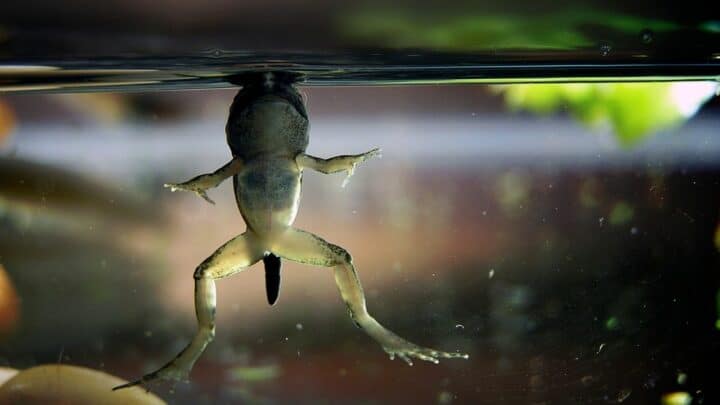Frogs are amphibians, which include salamander, toads, and newts. Frogs have several unusual traits, including the way they breathe.
5,000 species of frogs exist worldwide, and North America is home to 109 species.
The smallest of these species, the Little Grass Frog, is a tiny one-half to seven-tenths of an inch long. The largest species is the American bullfrog, which can grow as big as eight inches, and its tadpoles can grow to six inches in length.
Whether a frog is tiny or as big as a salad plate, they all have to breathe in common.
So, for example, they all breathe the same way, from tadpole to adult, to take in oxygen and expel carbon dioxide, and it is not the same way that we do it.
To learn more about how frogs breathe on land and underwater, read on for information about these croaking amphibians.
How Do Frogs Breathe?
Frogs can breathe through their lungs, skin, the insides of their mouths, and with gills. On land, frogs breathe through their mouths and process oxygen through their lungs. But, in water, they breathe through their skin. As tadpoles, they have gills. They may have gills and lungs during their transition to adult frogs.
Frogs Breathe through their Gills
Before a frog becomes a frog, it is a tadpole, and young frogs look a lot like minnows. At this phase of their lives, they breathe using gills, just how fish do.
When water flows across tadpoles’ gills, they take in oxygen from the water and remove the carbon dioxide.
As they grow, frogs have both lungs and gills for a short time, and once their lungs have developed, the frog’s skin grows over the gills.
When the gills are no longer present, the frog will breathe with their lungs when on land. However, even after developing mature lungs, they have several unique characteristics that aid breathing.
Frogs Breathe with their Lungs when on Land
It is now officially a frog when the tadpole has developed legs, lungs, and the tail is no longer obvious. Also, instead of using gills to breathe, it is now using lungs to do so.
However, it also uses its mouth to aid breathing. Frogs do not have a diaphragm, so it uses its mouth to force air in and out of its lungs.
This is how frogs take in oxygen, expel carbon dioxide, and breathe on land. The act of puffing up their cheeks forces the air into and out of their lungs.
That includes all frogs, whether in trees, on land, or in the water. When frogs are in the water, they have yet another organ for breathing, their skin.
Frogs Can Breathe through their Skin
Whether in the water or out, frogs use their skin to expel carbon dioxide, which is why frogs often look and are somewhat slimy. The damp skin of a frog helps them expel the gases produced when the lungs process oxygen.
When frogs are in the water, this is how they breathe, entirely, through their skin. When underwater, their skin behaves just as it does when on land but is the primary source of oxygen.
If frogs find themselves in water with a low oxygen level, they can drown unless they can get to land. Their water needs plenty of oxygen, too, for them to survive.
Even out of the water, frogs use their skin to aid their lungs with breathing. If a frog’s skin dries out, it can hamper its breathing and weaken the frog.
How Frogs Breathe through their Skin
The process amphibians use to breathe through their skin is called cutaneous gas exchange. This process enables them to draw oxygen from the air or water through their skin and exchange it for carbon dioxide.
The mucous coating of the skin of some frogs helps them breathe when out of the water. It can also contain chemicals that protect it from bacteria and fungus.
The frog suffocates and eventually dies if its skin dries out, it can suffocate and die.
When is a Frog a Toad, and a Toad a Frog: The Answer
Even though from the same family, toads are a sub-class of frogs. That means that you can consider all toads as frogs, but not every frog you see is a toad.
Are you confused yet?
The biggest difference is that toads are land-bound and do not live in the water, like some frogs. A more obvious difference is that toads have stubbier back legs, and most do not have webbed feet, like frogs.
Toads do not have the sticky toe pads that frogs use to cling to everything, either.
Frequently Asked Questions about How Frogs Breathe
Do frogs hibernate?
Aquatic frogs do. They will spend the winter in the water at the bottom of a pond, a lake, or other bodies of water. While there, they breathe through their skin during their sleep. Since they’re cold-blooded, the temperature of the surroundings reflects in their body temperature.
Why do frogs eat their skin?
Much like snakes and other animals, frogs shed their skin occasionally. But, instead of leaving their shed skin behind, as a snake does, they eat it because it is protein-rich and supplements their diet.
Frogs Breathe Differently than Humans
Even though they have lungs, once they transform from tadpoles to frogs, they use several ways to get oxygen into their bodies.
Most other amphibians in this family, the toad, newt, and salamanders, use the same breathing method as the frog.
However, not all of them use this bodily function to venture into the water. Toads are land-bound, as are some frogs.
Even though they can breathe underwater, they choose to keep their feet dry unless it is raining.


